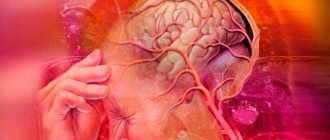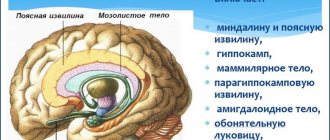general information
The oneiric state refers to qualitative disorders of consciousness. The second name is dream disorder. The disease was described at the end of the 19th century in patients with infectious and intoxicating psychoses. Later, similar disorders were discovered in schizophrenia.
The classic variant of the disease is oneiric catatonia, described in the type of schizophrenia of the same name. For a long time, experts believed that disturbances of consciousness with the appearance of fantastic pictures are characteristic only of schizophrenic disorders. However, at the end of the 20th century it was found that symptoms of oneiric stupefaction are observed in intoxication syndromes and organic brain damage.
Causes
Scientific research shows that the occurrence of the oneiric condition is closely related to genetic predisposition. In families where parents or close relatives have schizophrenia and other mental disorders, the risk of developing oneiroid is significantly higher.
The key factor in development is schizophrenia in a recurrent or catatonic form. Organic brain damage plays an important role: traumatic brain injuries, intracranial hematomas and neoplasms of any nature. Long-term use of drugs that affect the central nervous system and epilepsy increase the risk of oneiric condition.
The cause of the development of oneiroid is considered not only schizophrenia, but also other factors:
- intoxication with alcoholic beverages, narcotic drugs, as well as substances used for drug intoxication: acetone, glue, etc.;
- severe viral or bacterial infection, accompanied by fever and intoxication;
- inflammatory damage to the brain in the form of encephalitis, meningitis is also a risk factor, due to the possibility of inflammation spreading to nervous tissue;
- epilepsy with the development of psychosis; in addition, long-term use of anticonvulsants and organic changes as a result of epileptic seizures increase the risk of disturbances of consciousness;
- metabolic disorders in the body with the development of endogenous intoxication (a similar condition accompanies liver and kidney failure).
One patient may have several of these causes. Oneiric clouding of consciousness is detected in people of different ages. In the case of children, the disease is closely related to heredity. Moreover, their clinical picture intensifies as they grow older.
Symptoms and signs of oneiroid
Oneiric clouding of consciousness in its symptoms is similar to all types of clouding of consciousness, but has some differences. It is important to take into account the emotional component of this pathology, since the effect is very pronounced. With mania, the person is completely captured by his experiences, active, energetic, and with depression, he is drooping and sad, but still in his experiences. Their speech is quite slow, slurred and does not correspond to situational aspects. Thinking is fragmented, orientation is ambiguous, consistency is disrupted. Amnesia is incomplete and manifests itself in the form of memory impairment with pronounced memories of pathological experiences, but forgetfulness of real events. The effector-volitional sphere is also affected, instincts are reduced, emotions are inexpressive, the person is confused and drowsy.
Emotional disturbances are the first to form; the person is lethargic, lacking initiative, as if upset by something. But such a mood, like any other, is unstable and changes abruptly for no reason to another. Often such people are afraid to sleep, because their dreams are frightening, terrifying, and they try to avoid such terrible moments as much as possible. Insomnia is a common companion to disorders of consciousness. It is impossible to hide the signs of affect that have arisen; the person is moved or is in complete, as it seems to him, hopelessness.
When talking with a person, behavioral shifts will immediately be noticeable, which will manifest themselves in delusional ideas. Perceptual disturbances are also not uncommon in these conditions, and there may be illusions and scene-like hallucinations.
The dream-like oneiroid especially manifests itself in the presence of hypnagogic hallucinations, in which a person, closing his eyes, sees certain scenes and people. There will be no point in communicating with such patients; they speak in pieces, in broken words, and it is impossible to trace the thread of the conversation. The speech itself is slurred, changing, sometimes speeding up, sometimes slowing down. Self-orientation is partially preserved, but still it is impossible to maintain contact with a person, he is confused, speaks more to himself than to someone, and even indistinctly. In time, as well as in the place around them, they are absolutely not oriented; time drags on or runs by for them. At the same time, a person is confident in the artificiality of his actions; there are mental automatisms.
The universe of such a person changes radically, while the person performs the usual actions, but his consciousness lives an absolutely unique life of its own. At the same time, he does everyday things, at the same time fights evil, destroys the devil or cosmic evil.
Their facial expressions are not thematic; their faces may even be mimicic. Over time, this duality worsens, until a complete withdrawal into the world of dreams. The movements become similar to each other, he already falls into his dreamlike state so much that he is able to fail to notice real dangers.
It is also important to distinguish the underlying disease, since the symptoms are different. For infectious causes, there is intoxication and complaints from the head. In case of poisoning, there are additional complaints such as diarrhea and vomiting. When using drugs, it is important to seek an appropriate history.
Types of disease
In psychiatry, there are several approaches to classifying the types of oneiric clouding of consciousness. Psychiatrists use Demyanova’s classification, which takes into account the clinical picture.
According to it, oneiroid is divided into 4 types:
- dreamlike;
- dream-oriented;
- scenic-hallucinatory;
- fantastically illusory.
The latter form occurs in schizophrenia and is manifested by illusions that are built into the perceived picture of the world. At the same time, patients adequately perceive the surrounding reality. Pseudohallucinations occur rarely.
The oriented-dream type develops in psychoses that occur against the background of intoxication or organic brain damage. It is characterized by emotional disturbances and visual pseudohallucinations.
Scenic-hallucinatory stupefaction is manifested by the involvement of all senses - sight, hearing, smell and touch. A specific manifestation of this type of oneiroid is romantic scenes with fairy-tale content.
The dream-like type is characterized by depersonalization and disorientation in space and time.
In the clinical characteristics of oneiroid, there are 5 stages, which successively replace each other:
- The initial stage is characterized by prodromal non-specific manifestations: anxiety, emotional lability, disruption of the autonomic nervous system, etc.
- Stage of delusional mood. The patient's delusions crystallize and weakly expressed delusional ideas are formed. He begins to tell them to others, which often leads to a visit to a psychiatrist. The stage lasts several hours, but can last up to 6-7 days.
- The stage of crystallization of delirium. The nature of the delirium of the dramatization. The patient begins to think that the people around him play predetermined roles, and all actions lead to some planned outcome. The stage lasts from several days to 3-4 weeks.
- A period of acute paraphrenia with pronounced illusions of various contents. The patient considers himself better than those around him and may show aggression towards them. In most cases it lasts several hours, but can last for 1-2 days.
- The true oneiroid stage is manifested by a detailed clinical picture. Severe dream-like visions, catatonia and other symptoms appear.
A number of specialists in psychiatry highlight the stage of reverse development. It occurs against the background of medical care. Clinical symptoms of oneiric stupefaction decrease and completely disappear. At the same time, the patient begins to remember and tell delusional experiences and the content of pseudohallucinations.
The staging depends on the cause of the pathological condition. Thus, organic oneiroid, which occurs, for example, with brain injuries, manifests itself in a rapid change of stages. The true oneiroid stage can occur a couple of days after the prodromal period. The classic version of oneiric clouding of consciousness is observed in schizophrenia.
Medical educational literature
This state is a combination of sensory-figurative vivid ideas with a fragmentary reflection of real reality in the consciousness. The consciousness of patients is filled with vivid ideas, characterized by great variability, plasticity and special subjective authenticity for patients. Patients are disoriented in place, time and surrounding persons, but this is not a lack of orientation (as with stupor) and not a search for it (as with amentia), but a dream-like disorientation, since the patient in this state always experiences a certain situation in which he considers himself a participant.
The imaginative experiences of patients do not have an external projection (as in delirium), but are experienced inside consciousness, are representations and are distinguished by great coherence, since one dream-like experience follows from another, a third from the last, etc. Usually the theme of experiences during oneiroid in is mainly drawn from past experience (not always personally experienced), more often from books read, stories heard, films, etc. Due to some yet unstudied neurodynamic disorders in patients during the oneiroid period, the play of imagination sharply intensifies and, unlike ordinary laws of logical thinking, the connection of such (often fantastic) past experience with elements of the past experienced by the patient and with “pieces” of real reality increasingly prevails in consciousness. Thus, the consciousness of an oneiric patient is filled with the results of analytical and synthetic processing not of the real reality surrounding him, but of past experience (not only personally experienced, but also “borrowed”, sometimes fantastic). Such past experience, thanks to the special vividness of ideas, their richness, emotional richness and a sharp increase in the function of imagination, fills the consciousness, determines the patients’ orientation and assessment (in terms of such orientation) of the fragmentarily perceived reality.
Some patients in such cases, during oneiroid, imagine themselves rushing in a spaceship in interplanetary space, the people around in the ward (doctors, nurses and patients) are assessed as technical personnel who prepared the flight and partially participated in it; others imagine themselves at a grand ball by candlelight, surrounded by beautiful, unusually originally dressed people, and doctors and medical staff as educators who put themselves to work in this hall; still others feel themselves caught in the conditions of fascist occupation, go to a nearby forest (“to the partisans”), people passing by are mistaken for disguised German soldiers and traitors who have come into their service, etc.
Disorientation in the environment is always evident; it, along with the detachment of the patients and their inaccessibility to meaningful contact, results in a complete exclusion from the situation. As clinical experience convinces, the content of dream-like experiences in oneiroid may not be fantastic. Oneiric states are characterized by a certain (namely, dream-like) orientation, and the associative processes in these patients are not characterized by incoherence and difficulty of synthesis, but, on the contrary, by a large sequence of experiences (following from one another) and the preservation of the synthesis of mental processes [Mayer-Gross, 1924].
A comparison of oneiric and delirious syndromes shows undoubted differences in their psychopathological structure. Disorders of sensory cognition in delirium have an external projection and are hallucinations, while in oneiroid they do not have an external projection, are experienced in the field of consciousness, do not achieve visualization and are representations. The quality of stupefaction in delirium is hallucinatory, in oneiroid it is dream-like. The experiences of delirious patients - various hallucinations, illusions, sensory delirium, etc. - are usually incoherent, and in the minds of patients they quickly change as in a kaleidoscope, while dream-like experiences with oneiroid are distinguished by far-reaching coherence. Amnesia in delirium is more pronounced than in oneiroid, since these patients, upon recovery from psychosis, talk well about their dream-like experiences.
Oneiric syndrome (possible with exogenous and endogenous psychoses) usually does not last long, occurring in short episodes from several hours to several days (usually in the order of overlapping other syndromes) with clearing of consciousness between them and subsequent repetition.
If you find an error, please select a piece of text and press Ctrl+Enter.
Clinical picture
Oneiroid refers to disorders of consciousness. However, the first symptoms are manifested by changes in mood. Its lability is noted, which increases with time. During this period, the patient begins to see colorful dreams of various contents. Such changes lead to fear of madness. The sufferer does not share his feelings with others because he is afraid of visiting a psychiatrist. Symptoms of autonomic dysfunction gradually appear: frequent headaches, discomfort in the body, increased sweating, etc.
Mood disorders are progressing. Delusional ideas begin to form. At first they have the character of unsystematized delusions of death, persecution or hypochondria. Specific symptoms for oneiroid are Fregoli syndrome and Capgras. Capgras syndrome is called delusion of the negative twin. The patient believes that his friend or relative has been replaced by a double. In Fregoli's disorder, delusions of a positive double are noted - strangers are regarded by the patient as close people who have changed their appearance.
Gradually the delirium changes its content. It is filled with fantastic thoughts with apocalyptic or mystical ideas. Positive and negative hallucinations occur. During this period, a person becomes dangerous to others and himself.
In the absence of therapy, fantasies begin to displace reality. Contact with reality remains partially preserved. The patient tries to interact with her, but the level of activity is low. With oneiric-catatonic syndrome, contact is completely lost. A person stops responding to any external influences.
Diagnostic measures
The main method is collecting anamnesis and taking into account existing symptoms. The psychiatrist necessarily talks with the patient’s relatives, as they make it possible to establish the duration and possible cause of the development of the pathology. During the diagnostic process, it is important to identify the fact of taking drugs, alcohol, previous traumatic brain injuries, etc.
To identify organic diseases and the causes of the development of oneiric stupefaction, laboratory and instrumental examination methods are carried out:
- clinical and biochemical blood tests - with the help of which the general health of the patient is assessed and concomitant diseases of the internal organs are identified;
- electroencephalography – carried out if epileptic oneiroid is suspected, this syndrome develops against the background of epilepsy (EEG allows us to identify epileptogenic foci in the patient’s brain);
- computed tomography and magnetic resonance imaging to assess the state of brain structures (methods are shown to all patients after stabilization of their condition);
- Ultrasound of cerebral vessels with Doppler sonography to assess the degree of blood supply to the brain.
Pathology is rarely detected at the initial stages of its development. This is due to the fact that the symptoms are not specific, and there are no disturbances of consciousness.
A differential diagnosis with onirism is carried out. The patient loses the ability to distinguish between reality and dreams. The latter may have fantastic content. A distinctive feature of onirism is the absence of hallucinations and pseudohallucinations.
Treatment approaches
If symptoms of oneiric syndrome are detected, the patient needs to be hospitalized in a neuropsychiatric dispensary. Therapy is always comprehensive and prescribed by a psychiatrist. Self-medication or attempts to use traditional methods are unacceptable. Oneiroid is capable of rapidly progressing, leading to inappropriate behavior.
Treatment depends on the identified cause of the syndrome.
Detection of a neuroinfection (encephalitis or meningitis) is an indication for the prescription of antiviral agents or antibiotics. In the first stages of treatment, broad-spectrum medications are selected. After the pathogen is identified, the drugs are changed to more effective ones. Medicines are administered intramuscularly, intravenously, and in severe cases of neuroinfection into the spinal canal. In case of surgical pathology (hematoma, tumors, etc.), operations are performed to eliminate them.
The main group of drugs for eliminating oneiroid clouding of consciousness are nootropics. These are drugs that normalize brain function and improve brain activity. In addition, nootropics restore the activity of the autonomic nervous system. Phenotropil, Piracetam and other drugs are prescribed for treatment. Preference is given to drugs that have injectable forms. For severe pseudohallucinations and delusions, antipsychotics are used, primarily atypical ones - Risperidone and its analogues. At the beginning of therapy, a therapeutic dosage is used, after which it is gradually reduced. Drugs in this group eliminate signs of depersonalization, hallucinations of any origin and delusional ideas.
If conservative treatment fails, electroconvulsive therapy is prescribed. It allows you to restore the balance of neurotransmitters in the brain and eliminate symptoms.
If you consume alcohol, drugs or chemical intoxication of the body, urgent measures are taken. They are aimed at detoxification. For this purpose, infusion therapy with intravenous administration of crystalloid solutions is prescribed. In severe cases, extracorporeal detoxification is carried out in the form of hemodialysis and other methods.
Main groups of drugs:
- sleeping pills - Ridazine, Sodium hydroxybutyrate, etc., put the patient into a state of sleep in which he is not dangerous to himself and others;
- Relanium and other tranquilizers - eliminate anxiety and restlessness of a person, in addition, partially reduce the severity of delirium;
- to reduce symptoms of intoxication, Cytoflavin, Sodium thiosulfate and their analogs are used;
- decongestants (Lasix, Mannitol) reduce the risk of developing cerebral edema, a characteristic complication of various intoxications.
The choice of medications is always made by the attending physician. Psychotropic drugs have an extensive list of contraindications that should be taken into account when using them. Ignoring restrictions can cause the progression of mental disorders and the development of side effects of the therapy.
Causes of oneiroid
Oneiroid is a nonspecific pathological picture, that is, there is no one characteristic disease that causes its occurrence. There are many reasons for this pathology, as well as for all kinds of clouding of consciousness. But there is still a basic division of this pathology. The endogenous nature of the diseases that cause oneiroid are typical psychiatric pathologies. Schizophrenia can be accompanied by such conditions, and its oneiric-catatonic form is not diagnosed if there were no such conditions. Very rarely, in the so-called psychotic form of bipolar disorder, a oneiroid-type state can occur, then a pronounced affect occurs, manic or, more often, vice versa.
If an oneiroid has an external cause that does not come from the brain itself, then such a cause is called exogenous. All intoxication subspecies do not depend on the chemical nature of the substance. This condition can be caused by chemical poisoning, substance abuse using office supplies, gasoline, and solvents. Drug addiction can also lead to such consequences.
Alcoholic oneiroid occurs as a worsening of delirium in a person suffering from alcoholism. Its occurrence is directly related to stopping alcohol intake for a certain period after long binges. This condition is possible not only after alcohol withdrawal, but also with the use of low-quality alcohol substitutes and poisoning with them.
In medicine, the oneiroid state can also arise, not only with diseases, but also with the relief of some. For surgical pathology, anesthesia is used that can cause confusion, for example, oneiroid. There are many viral diseases, especially in children, that lead to intoxication and the subsequent development of this pathological condition, these are: influenza, ARVI, chicken pox, EBV, infectious mononucleosis, CMV. Bacterial diseases with fever are also accompanied by oneiroid, especially massive septic complications. In the case of damage directly to brain tissue, psychiatric symptoms are inevitable, therefore oneiroid is a companion to meningoencephalitis of almost any etiology.
Epilepsy, as a neurological disease, manifests itself not only in the form of convulsive seizures that are familiar to us, but also in the form of their equivalents. With a long course of the disease, psychosis occurs, and oneiroid as a subtype of clouding of consciousness is also possible, but much less common than twilight.
Non-infectious diseases also often provoke clouding of consciousness in the form of oneiroid. The body is especially affected when there are significant disturbances in material metabolism and damage to blood vessels.
Oneiroid after a stroke occurs in severe forms of this disease with severe vascular lesions. Myocardial infarction and all types of insufficiency in the body can also provoke oneiroid. Rheumatological disorders, especially vasculitis and lupus, easily provoke oneiric conditions due to disruption of vascular function. A lack of individual vitamins or complexes, for example, advanced pellagra due to impaired metabolism of brain mediators, provokes oneiroid. Endocrinological problems and neoplasia are also provocateurs of oneiroid, due to their metabolic disorders and powerful intoxication mechanisms.
Recovery period
Rehabilitation after oneiroid is an important part of restoring social and professional life. During the recovery period, the patient should adhere to the following recommendations:
- When using antipsychotics in the acute period of oneiric syndrome, their use continues. The dosage is reduced by 2 or 4 times. The doctor’s task is to select a dosage regimen that ensures no relapses with minimal risk of side effects.
- Individual psychotherapy is provided. The specialist helps to cope with residual manifestations of the disease, as well as normalize social activity. It is possible to conduct group sessions of psychotherapeutic assistance.
- If the patient had organic brain damage, motor rehabilitation is carried out, which consists of physical therapy, massage and kinesiotherapy.
During the rehabilitation period, a person needs a positive emotional environment in the family and at work. Stressful situations can lead to a relapse of oneiroid symptoms.
Prognosis and prevention of pathology
The prognosis is positive. With timely administration of therapy, the symptoms completely disappear and complete recovery occurs. Relapses are possible if the causative factors persist. If the patient does not seek medical help or is given inappropriate treatment, delusions and pseudohallucinations progress. They can cause inappropriate behavior with aggression and harm to themselves and others.
Prevention of the development of oneiroid is carried out in patients suffering from schizophrenia and other diseases that can cause impairment of consciousness. Prevention is based on the following recommendations:
- avoiding the use of alcoholic beverages and the use of drugs;
- following the instructions of the attending physician on the treatment of the underlying pathology; you cannot independently cancel prescribed medications, change their dosage or replace medications with analogues;
- reducing stress levels in personal and professional life;
- attending individual or group psychotherapy.
If you experience vivid dreams with fantastic content, you should immediately consult your doctor.
You may also be interested in:
Prevention and treatment
Any independent treatment of oneiroid should be completely excluded. If the visions are caused by the use of alcohol or drugs, the patient must get rid of the bad habit under the supervision of the attending physician and undergo treatment prescribed by a specialist.
The best prevention in this case is to refuse even occasional use of the substance that caused oneiric syndrome.
In cases where the management is related to mental illness, the patient will face even more serious complex treatment in a psychiatric clinic. In addition to the main therapy, the doctor may prescribe symptomatic therapy. Most often, complex treatment includes 3 main components:
- Nootropic drugs . Medicines in this group have a positive effect on the autonomic system and conditioned reflexes. The tasks of nootropics include restoring brain activity impaired by the disease and improving memory.
- Neuroleptic drugs . Designed to maintain emotional stability and stop hallucinations.
- Electroconvulsive therapy . This method is not always used. Many specialists prefer to turn to him only in the most extreme cases. Electroconvulsive therapy has a number of contraindications. However, its effectiveness has been confirmed in the treatment of hundreds of patients.
As a preventative measure, the patient should be regularly examined by his or her physician, especially if he or she has been diagnosed with schizophrenia.










